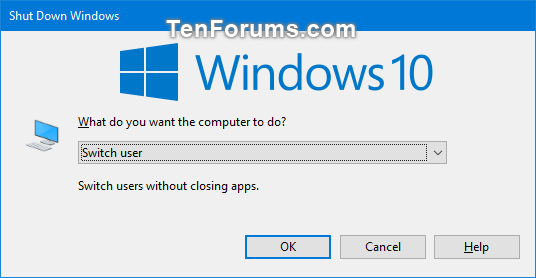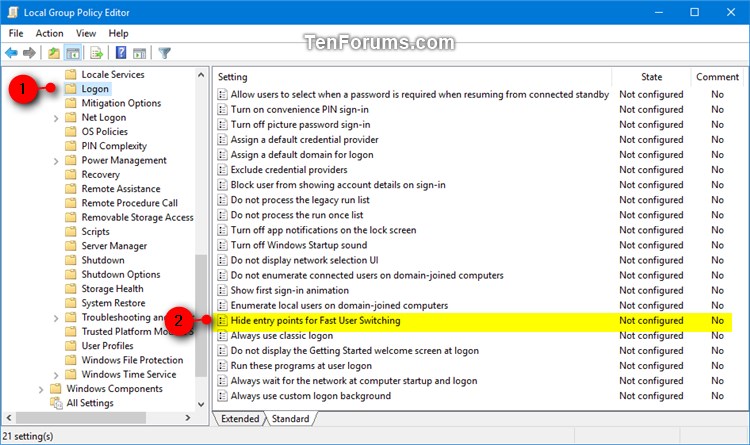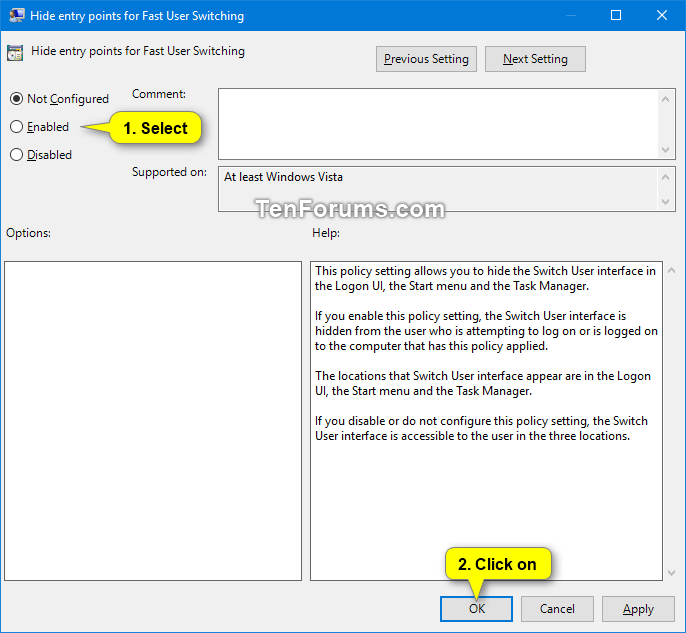How to Enable or Disable Fast User Switching in Windows 10
If you have more than one user account on your PC, Fast User Switching is an easy way for you to switch between accounts or for another user to sign in to Windows without signing you out or closing your apps and files.
If you like, you can disable Fast User Switching to hide the Switch user interface (entry points) for all users.
This tutorial will show you how to enable or disable all Fast User Switching entry points for all users in Windows 10.
You must be signed in as an administrator to enable or disable Fast User Switching.
Contents
- Option One: To Enable or Disable Fast User Switching in Local Group Policy Editor
- Option Two: To Enable or Disable Fast User Switching using a BAT file
EXAMPLE: Switch User entry points (interfaces)


The Local Group Policy Editor is only available in the Windows 10 Pro, Enterprise, and Education editions.
All editions can use Option Two below.
1 Open the Local Group Policy Editor.
2 Navigate to the location below in the left pane of Local Group Policy Editor. (see screenshot below)
Computer Configuration\Administrative Templates\System\Logon
3 In the right pane of Logon in Local Group Policy Editor, double click/tap on the Hide entry points for Fast User Switching policy to edit it. (see screenshot above)
4 Do step 5 (enable) or step 6 (disable) below for what you would like to do.
A) Select (dot) Not Configured or Enabled, click/tap on OK, and go to step 7 below. (see screenshot below)
[n2]Not Configured is the default setting.[/I]
7 When finished, you can close the Local Group Policy Editor if you like.
The downloadable .bat files below will change the DWORD value in the registry keys below.
HKEY_CURRENT_USER\Software\Microsoft\Windows\CurrentVersion\Policies\System
HKEY_LOCAL_MACHINE\SOFTWARE\Microsoft\Windows\CurrentVersion\Policies\System
HideFastUserSwitching DWORD
<Delete> = Enable
1 = Disable
1 Do step 2 (enable) or step 3 (disable) below for what you would like to do.
This is the default setting.
A) Click/tap on the Download button below to download the BAT file below, and go to step 4 below.
Enable_Fast_User_Switching.bat
Download
A) Click/tap on the Download button below to download the BAT file below, and go to step 4 below.
Disable_Fast_User_Switching.bat
Download
4 Save the .bat file to your desktop.
5 Run the .bat file, and unblock the .bat file if required.
6 Click/tap on Yes when prompted by UAC to have the .bat file run as administrator.
7 You will now notice your screen flicker as a command prompt quickly opens and closes to apply the registry changes and restart the explorer process.
8 You can now delete the downloaded .bat file if you like.
That's it,
Shawn
Related Tutorials
- How to Switch User in Windows 10
- How to Create a Switch User Shortcut in Windows 10
- How to Add or Remove Sign out Option in Windows 10
Enable or Disable Fast User Switching in Windows 10

Enable or Disable Fast User Switching in Windows 10
How to Enable or Disable Fast User Switching in Windows 10Published by Shawn BrinkCategory: User Accounts
05 Mar 2020
Tutorial Categories


Related Discussions






